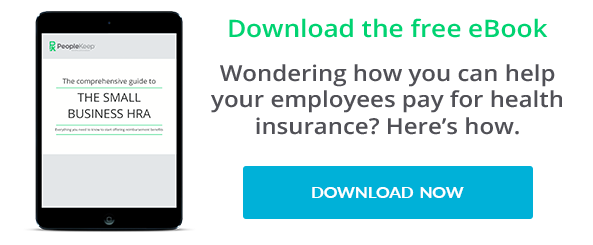How the 'Death Spiral' is Shaping Small Employer Group Health Insurance
Small Business • May 23, 2014 at 7:00 AM • Written by: PeopleKeep Team
We often discuss how the current small employer group health insurance market is unstable, broken, and undergoing a major transformation. To understand where we are today, it's important to understand what happened during the 1980s and 1990s that set in motion what many call the small employer health insurance death spiral.
This article is an excerpt from our Whitepaper "The Inevitable End of Small Business Health Insurance" (click to download).
1980s and 1990s – Guaranteed Issue Health Insurance for Small Businesses
By the late 1980s and early 1990s, the small business health insurance market became unstable as many insurers only wanted to insure the healthiest groups. As a result, in the early 1990s, most states adopted a version of the National Association of Insurance Commissioners’ (NAIC) "Small Employer Health Insurance Availability" Model Act in an attempt to address this market instability.
The NAIC act stated that insurance companies, as a condition of doing business in a state, had to “Guarantee Issue” certain plans to small employers (typically defined as 2 to 49 employees). However, small employers could be turned down if they did not meet minimum participation requirements and/or minimum employer-contribution-to-premium requirements set by the insurer.
While the NAIC act did make health insurance more accessible to small businesses, it did not address affordability. Facing double-digit growth in health insurance premiums, many small employers either ceased offering health benefits or redesigned the plans with higher cost-sharing by employees.
These annual benefit reductions and/or increased out-lay by employees inevitably led to an on-going version of adverse selection – a perpetual process referred to as the small employer group health insurance death spiral.
What is the Small Employer Group Health Insurance Death Spiral?
The death spiral starts when an employee’s cost to participate in the employer plan exceeds the employee’s willingness to pay. When this happens, the healthiest employees begin to drop off the employer plan in favor of individual policies. This causes the remaining small employer risk pool to become “sicker”, resulting in higher insurance premiums on renewal the following year.
Then, the process repeats. Again, the employer reduces benefits to maintain costs, more healthy employees drop off, and the rate goes up the following year.
This death spiral perpetuates until the small business either: (1) cancels the plan; or (2) is unable to meet the minimum contribution requirements or minimum participation requirements set by the insurer, and the plan is canceled by the insurer.
What this Means for Small Employer Health Insurance
By the 2000s, the small employer group health insurance death spiral had begun to run its course. Facing double-digit growth in health insurance premiums, many small businesses either eliminated health benefits or redesigned the plans to include higher deductibles, larger co-payments, and greater premium-sharing by employees.
This price pressure has created a paradigm shift in the way small businesses offer employee health benefits – a shift from an employer-driven “Defined Benefit” model to an individual-driven “Defined Contribution” model. While this shift has been slow to develop since the late 1980s it is accelerating in 2014 due to the Affordable Care Act.
Download the new Whitepaper to read more about the history and future of small employer health insurance.

